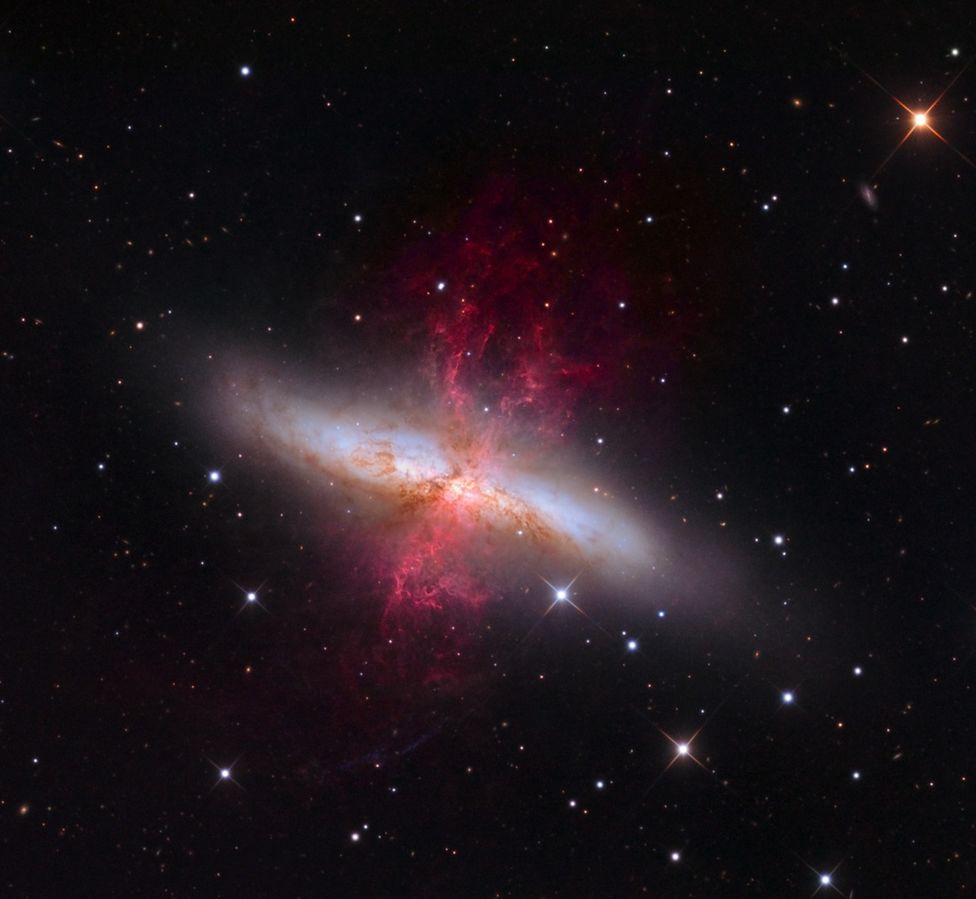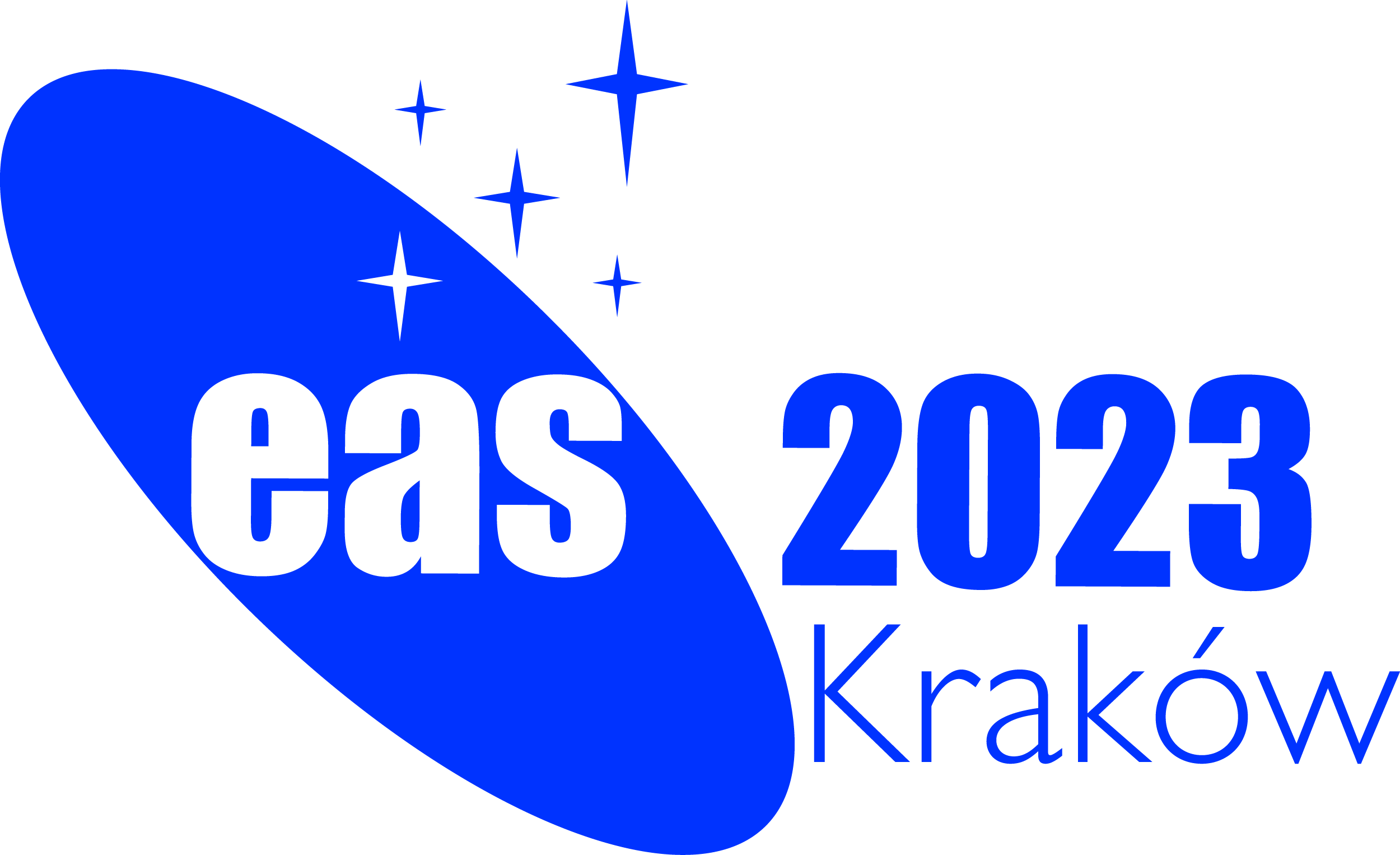Symposium S6
13-14 July 2023
Baryonic feedback, magnetic fields and cosmic rays in galaxy evolution
News:
Many thanks for participating in the Symposium S6 and EAS2023! Please notice that speakers share their presentations on the #s6 channel of the the EAS2023 slack platform. You can also download ePosters from the poster gallery.
Aims and scope
 The aim of this symposium is to bring together scientists working on the role of magnetic fields, cosmic rays and feedback processes on galaxy evolution, connecting the observational and theoretical point of view to constrain the largely unknown parameters.
The aim of this symposium is to bring together scientists working on the role of magnetic fields, cosmic rays and feedback processes on galaxy evolution, connecting the observational and theoretical point of view to constrain the largely unknown parameters.
The effective transport speed of CRs regulates the efficiency of galactic outflows and winds. Simplified CR diffusion and a universal diffusion coefficient, which is currently often used in numerical modeling and analysis of observations, cannot explain the observed variety in galactic outflows. We will discuss the latest progress in CR modelling, the current limitations and the next steps needed to improve the models.
Closely connected to the CR transport is the structure and strength of the magnetic field. The local CR losses, which are visible via gamma ray and radio observations for CR protons and electrons, respectively, correlate with the local gas density, star formation, and the magnetic field strength. Complementing the modelling of CR physics with accurate mock observations is therefore crucial for detailed comparisons with real systems. The symposium will allow us to specify the complexity of numerical and theoretical modelling that is needed to draw reliable conclusions. From the observational side, the rapid advances with SKA-era radio interferometers allow us to look at the properties of the interstellar medium with unprecedented accuracy. We want to make the community aware of upcoming upgrades and future developments and explain the new possibilities for studying galaxies with these new tools.
Polarisation by dust in emission and extinction is also a tracer of the magnetic field geometry. These observations remain difficult, but are becoming routinely available, in particular at high angular resolution, with facilities such as ALMA. They offer the possibility of revealing the magnetic field structures in the dense regions forming stars, and as such, are complementary to synchrotron observations. With the aim of building a coherent picture of magnetic fields in the galactic interstellar medium, we will present the current status of these observations and discuss the theory explaining them.
* Fig. M82 Credit https://en.wikipedia.org/wiki/File:
M82_Galaxy_ from_the_Mount_ Lemmon_ SkyCenter_ Schulman_Telescope_
courtesy_ Adam_Block.jpg
Programme
The S6 Symposium consists of six 1.5-hour blocks and will be held in Auditorium S3 B on Thursday and Friday
13.07 Thursday:
- Block S6a. The role of cosmic rays in galactic winds (chair: Volker Heesen)
- Block S6b. Dust polarisation as magnetic fields tracer: theoretical perspective (chair: Rosita Paladino)
- Block S6c. CR transport: theory, modelling and observations (chair: Michal Hanasz)
14.07 Friday:
- Block S6d. Stunning observations, state of the art, and perspectives of radio interferometry instruments (chair: Krzysztof Chyży)
- Block S6e. Cosmic rays and other feedback mechanisms (chair: Maria Werhahn)
- Block S6f. Dust polarisation as magnetic fields tracer: observational perspective (chair: Rosita Paladino)
Invited speakers
- Alexander Lazarian (University of Wisconsin-Madison, USA) (Block S6b)
- Claudia Cicone (University of Oslo, Norway) (Block S6a)
- Francesco de Gasperin (INAF-Istituto di Radioastronomia, Bologna, Italy) (Block S6d)
- Ian Heywood (University of Oxford, United Kingdom) (Block S6d)
- Enrique Lopez-Rodriguez (Stanford University, USA) (Block S6f)
- Bernd Vollmer (University of Strasbourg, France) (Block S6e)
- Maria Werhahn (Max Planck Institute for Astrophysics, Garching, Germany) (Block S6c
- Theresa Wiegert (Instituto de Astrofísica de Andalucía in Granada, Spain) (Block S6a)
Scientific organisers
Krzysztof Chyży, Jagiellonian University in Kraków, Poland (chair)
Volker Heesen, Hamburg University, Germany (co-chair)
Michal Hanasz, Nicolaus Copernicus University in Toruń, Poland (co-chair)
Rosita Paladino, INAF-Institute of Radioastronomy (IRA), Italy (co-chair)
Philipp Girichidis, Heidelberg University, Germany
Cathy Horellou, Chalmers University of Technology, Sweden
Ancla Müller, Ruhr University Bochum, Germany
Jean-Philippe Bernard, IRAP-Toulouse, France
Contact
krzysztof.chyzy @ uj.edu.pl (Krzysztof Chyży)
volker.heesen @ hs.uni-hamburg.de (Volker Heesen)
mhanasz @ umk.pl (Michal Hanasz)
rosita.paladino @ inaf.it (Rosita Paladino)
Updated on Fri Jul 21 01:35:10 CEST 2023
|

 A power cut will shut down all EAS services on Tuesday, 10 January 2017 starting at 7:30 CET.
A power cut will shut down all EAS services on Tuesday, 10 January 2017 starting at 7:30 CET.


